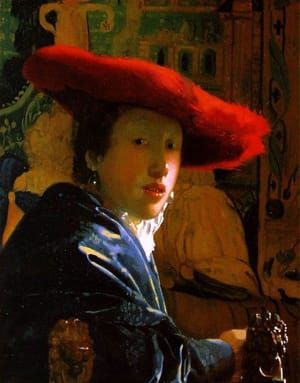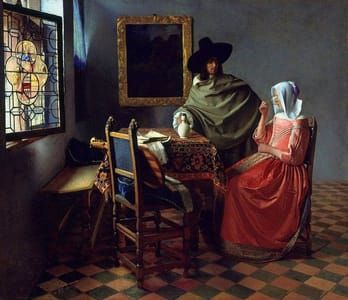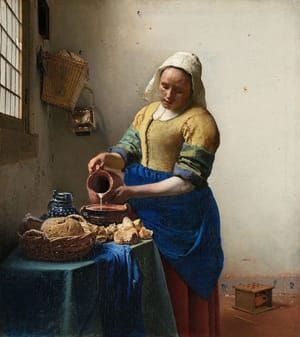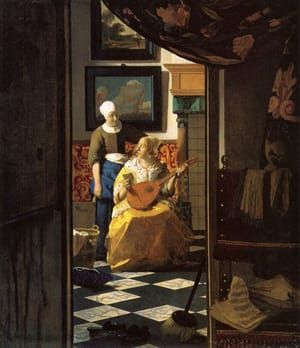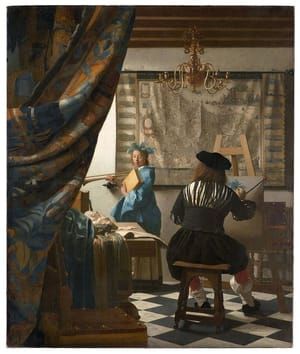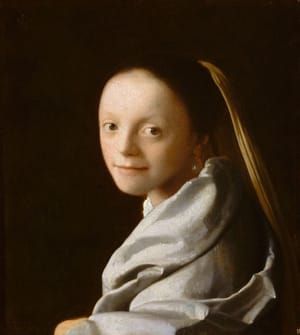
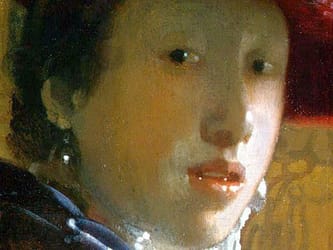
Girl With A Red Hat, 1665-1666
Johannes Vermeer
Girl with a Red Hat is a rather small painting, signed by the Dutch painter Johannes Vermeer. It is seen as one of a number of Vermeer's tronies – depictions of models fancifully dressed that were not (as far as is known) intended to be portraits of specific, identifiable subjects. Other believe it is a portrait. Whether Vermeer chose family members as models or found them elsewhere in Delft is irrelevant to the appreciation of his paintings. Its attribution to Vermeer – as it is on a (recycled) wood panel and not on canvas – has been a matter of controversy with scholars on both sides of the argument.
The painting, supposed to be executed 1665–1666, may have been among those owned by Vermeer's patron, Pieter Claesz van Ruijven and possibly, through inheritance it may have been passed on to his wife, Maria de Knuijt who died 1681; her daughter, Magdalena van Ruijven; and Magdalena's husband, Jacob Abrahamsz Dissius. It is thought to have been sold on an auction in Amsterdam on May 16, 1696 (probably no. 38, 39 or 40)....
(https://en.wikipedia.org/wiki/Girl_with_a_Red_Hat)
Aside from the expectant expression on the young woman's face, much of the vivacity of this extraordinary painting stems from the manner which it is painted. The reflections of light take shape as pale, densely applied brushstrokes of white and yellow paint which animate the surfaces of the different objects and materials and bring them close to the picture surface, reminding us that we in looking at a painted object in contrast to these strongly lit areas, the red hat and blue garment are painted over darker under layers, which give the colors warmth. The sumptuousness of the materials and the depth and intensity of the color range used by Vermeer contributed to the sense of warmth which is a key element in this work's aesthetic.
[http://www.essentialvermeer.com/cat_about/hat.html]
...Although not so obviously based on the delicate glazes that mesmerize viewers of Girl With A Pearl Earring, their cunning use in Girl With A Red Hat harmonizes the muted colors of the tapestry that provides the background for the young woman in her theatrical red hat. And what a hat the artist makes it: feathery strokes of orange shade gradually to vermillion, the underside of the hat definitely deep purple, reflecting light onto her face through flecks of white paint. This is what luminance does, it makes us see light where it is not but ought to be. Luminance is the term of art for the relative brightness that enables us to interpret three-dimensional space in two dimensional representations.
In his own lifetime Vermeer (1632-1675) was a moderately successful painter although his portraits and other commissions were sorely stretched to support the fifteen children Johan and his wife Catharina produced. So it may be unsurprising that no documents in Vermeer's own words have come down to us. Considering the silliness of some of the speculations that have been committed to paper about the origins of Vermeer's paintings, critics might do better to follow Vermeer's own example.
[http://thebluelantern.blogspot.nl/]
Uploaded on Dec 27, 2017 by Suzan Hamer
Johannes Vermeer
artistArthur
Wait what?
